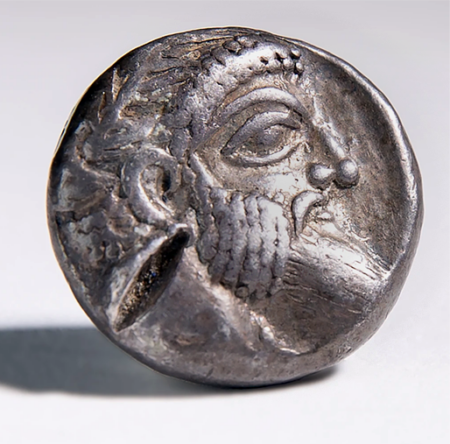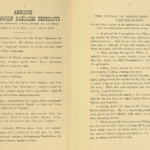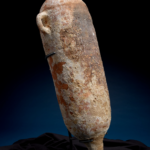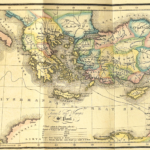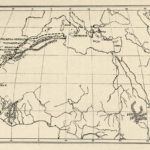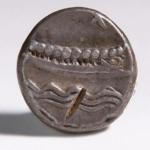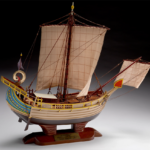Phoenicians & Hanno the Navigator
Explorer
Ancient
Quick Facts:
One of the earliest known seafaring cultures, the Phoenicians sailed throughout the Mediterranean Sea, into the Atlantic Ocean, establishing trade routes and great cities.
Introduction
The Phoenicians are among the earliest seafarers in history. Although we call these people Phoenician today, they were actually Canaanites. Meaning, they were from the land of Canaan. The ancient Greeks called the Canaanite region “Phoenicia” in the Greek language.1 Ancient Greek language has survived over the centuries. As their language spread and was translated, many of the words they used are what we still use today. For several hundred years, Phoenicians explored, traded, and established settlements throughout the Mediterranean region. It is also widely believed that they sailed down to the southern tip of Africa long before explorers like Bartholomew Dias did.
Biography
Early Life
Phoenicia was in the northern part of Canaan in what is present day Lebanon, along the eastern Mediterranean coast. Phoenician history begins around 3000 BCE, when they were still more a part of the Canaanite culture. The Mediterranean Sea and the surrounding lands were where many great western civilizations were. The Mediterranean Sea borders Europe to the north, Asia to the east, Africa to the south, and it connects to the Atlantic Ocean to the west. The part of Asia that borders the eastern part of the Mediterranean Sea is known as the Levant. The word Levant comes from French, meaning “to rise.” This land is called “Levant” because it lies to the east, where the sun rises. It is in the Levant area where the Phoenicians initially lived.
Their main home city in Phoenicia was Tyre. However, other cities include Sidon and Byblos. In these, and other cities, the Phoencians became expert craftsmen and manufactured many goods. Cedar wood was a main product coming out of Phoenicia. But their most popular and profitable product was a purple dye known as Tyrian purple.2 It was named after the city of Tyre. The dye was produced from the mucus of the Murex snail. Because it took many snails to make just small amounts, Tyrian purple was very expensive to buy. The color purple soon became a symbol of wealth and power to those who wore the color. They carried many trade items, especially liquids, in jars called amphora. Over time, rather than simply taking up farming and agriculture, the Phoenicians took to the sea. During the time of the Phoenicians, not much was known about the world. Venturing out to sea was much more dangerous, because they did not always know where they were going. And they did not always have many tools to help them navigate. But this did not stop the Phoenicians from soon becoming some of the greatest seafarers in early history.
Voyages
Principal Voyage
Around 1500 BCE, Phoenician culture and seafaring began to thrive. Phoenician merchants began sailing in merchant ships throughout the Mediterranean Sea as part of trade voyages. They went first to nearby places like Cyprus, and slowly sailed further out across the sea.3 Unlike later explorers, the Phoenicians did not really have tools to help them navigate. So they relied on natural resources around them. In their early journeys, they stayed closer in sight of coastlines. As they became familiar with the landscaped and natural features of places along the coast, they could figure out where they were. They also used the wind and currents to help them. Like the wind, currents can affect how fast or slow ships move. You can travel faster with the currents than going against them. Soon they had mastered ways to navigate throughout the sea. As they sailed further west, they began setting up colonies and port cities specifically for trade.
The Phoenicians established major port cities and colonies in many places. Gades (now called Cadiz) all the way in present day Spain was a major city and trading center developed by the Phoenicians. Islands like Malta, Sicily and Sardinia were also settled by the Phoenicians. Much of the northern part of North Africa was also established, including cities like Tangier, Morocco. But perhaps no other port city was as important as the great city of Carthage. It was located in North Africa, in what is now Tunisia. Founded in 814 BCE, Carthage was a major harbor, port and trading epicenter of the Mediterranean world. It remained a powerful city for several hundred years until 146 BCE. After a series of three wars known as the Punic Wars, Carthage was conquered by the Romans. But during Carthage’s long reign, the people of Carthage and Phoenicia proved why they were a great maritime empire. Bold sailors from Phoenician colonies would sail further than ever before out into the Atlantic Ocean sailing to parts of West Africa.
Subsequent Voyages
The Phoenicians are among the first people to sail past the Strait of Gibraltar, into the Atlantic Ocean to Sub-Saharan Africa.4 Hanno (also called Hanno the Navigator) was a citizen of Carthage who lived during the 5th century BCE. Not much is known about Hanno’s life other than the voyage he made. In or about 520 BCE, the Carthaginian government directed Hanno to explore and colonize parts of West Africa. He set sail with 60 vessels holding 30,000 men and women, and supplies for their long journey.5 They left Carthage, sailed west through the Pillars of Hercules (called the Strait of Gibraltar today) into the Atlantic Ocean, then south down West Africa’s coast. Along the way, he founded several cities. Settlers were left behind at these cities to grow them into colonies. The expedition explored the lands, and came upon rivers full of crocodiles and hippopotamuses.6 They encountered African peoples on their voyage as well. Some were friendly and welcoming, and helped the Carthaginians learn. Some who were less friendly and kept the Carthaginians away.
They continued on their journey for sometime. In the end, Hanno’s expedition sailed down most of the West African coast. They made it down to a point he referred to as the Horn of the South. Here, Hanno explains an encounter with an animal called a gorilla. It was not a good encounter, as the gorillas were said to be scary and aggressive. Still, this is the earliest known mention of gorillas.7 They began to run out of supplies and returned home. Historians are unsure of the exact length of Hanno’s journey. But many historians agree that he covered about 2600 miles of African coastline.8 Historians also believe that he made it at least as far as present day Sierra Leone, if not farther, to parts of present day Gabon. Some historians even credit Hanno, or another Phoenician fleet, for sailing all the way around the continent of Africa several thousand years before Bartholomew Dias and Vasco da Gama.9 Regardless, Hanno’s expedition down the African coast was one of the first successful trips of its kind.
Later Years and Death
Hanno documented his journey in a work now called The Periplus of Hanno. The word Periplus simply means, “a voyage around something; circumnavigation.” Unfortunately, as larger Mediterranean powers came into existence, Phoenicia as a superpower civilization soon came to end. The Assyrians and Babylonians to the east of Phoenicia conquered much of the Levant area inhabited by the Phoenician people. In 332 BCE, the conqueror Alexander the Great destroyed Tyre, and the city fell under his control. The rise of the Roman Empire in 27 CE saw major changes to the entire Mediterranean region. As Rome expanded and conquered the Mediterranean, many civilizations, like the Phoenicians fell or and became a part of the Roman Empire.
Legacy
Phoenicians were one of the earliest seafaring peoples They surveyed, explored, and traded throughout the Mediterranean Sea. They encountered and influenced many cultures like the Greeks, Egyptians, and later, the Romans. The Phoenicians left behind little literature and art. Much of what we know about them comes from other sources, like Greek literature, Roman history, and even the Christian Bible. One major contribution the Phoenicians gave the western world was creating a more efficient alphabet. They created an alphabet of twenty-two consonant symbols. Later, the Greeks added in some letters and vowels.10 The development of the alphabet allowed western cultures to write down their stories and histories, which we still tell today. The Phoenicians had many great achievements during their time which have made a lasting impact on our world.
Gallery
- Greek and English translation of Hanno’s documentation of his periplus. [PRIMARY SOURCE] The Mariners’ Museum from G88.5 .H24 Rare
- Amphora jars were used by Phoeicians and other Mediterranean cultures to hold trade goods. The Mariners’ Museum 1992.0003.000001
- This map shows where Phoenicia was located on the eastern coast of the Mediterranean Sea. The Mariners’ Museum from G2453.1 B5 P2 Rare
- Map showing the periplus or circumnavigation of Africa’s coast by Hanno. The Mariners’ Museum from G88.5 .H24 Rare_Map
- Ancient coin from the city of Aradus showing a galley ship with Phoenician rowers. The Mariners’ Museum 1937.0483.000006 (reverse)
- Model of a Phoenician merchant ship that would have been used in ancient trade. The Mariners’ Museum 1960.0077.000001
Endnotes
- Thomas Walter Wallbank, Civilization Past & Present Volume 1, sixth edition (Illinois: Scott, Foresmand and Company, 1987), 24.
- Wallbank, Civilization Past & Present, 24.
- Kingfisher, The Kingfisher History Encyclopedia (New York: Larousse Kingfisher Chamber, Inc., 1999), 29.
- Carolina López-Ruiz, Phoenicians and the Making of the Mediterranean (Massachusetts: Harvard University Press, 2021), 120.
- Wilfred H. Schoff, trans., The Periplus of Hanno, A Voyage of Discovery Down the West African Coast by a Carthaginian Admiral of the Fifth Century B.C. (Philadelphia: The Commercial Museum, 1913), 3.**
- Schoff, The Periplus of Hanno, 5.
- J.A. Brendon, Great Navigators & Discoverers (London: George G. Harrap & Co. Ltd., 1932), 20.
- Schoff, The Periplus of Hanno, 10.
- Schoff, The Periplus of Hanno, 20-21
- Wallbank, Civilization Past & Present, 25.
**PRIMARY SOURCE MATERIAL The Mariners’ Museum G88.5 .H24 Rare

